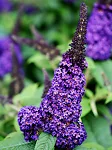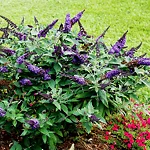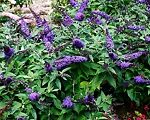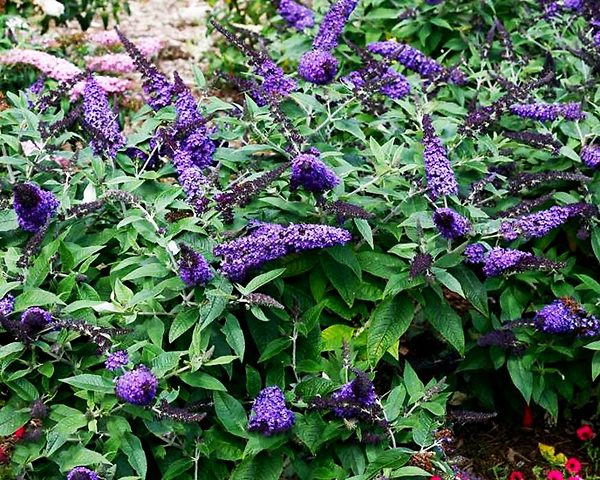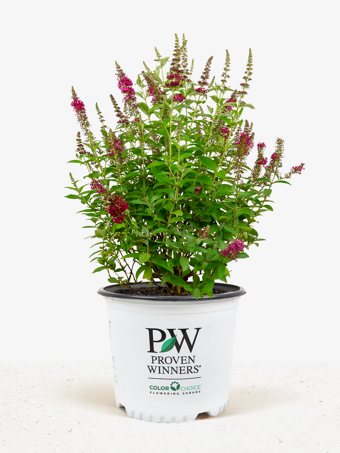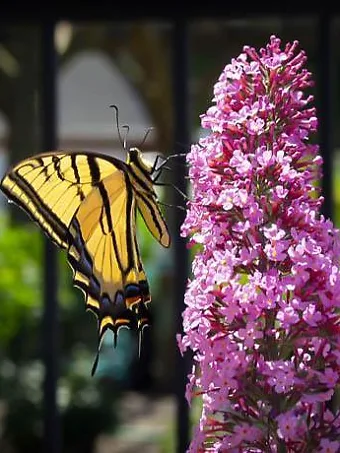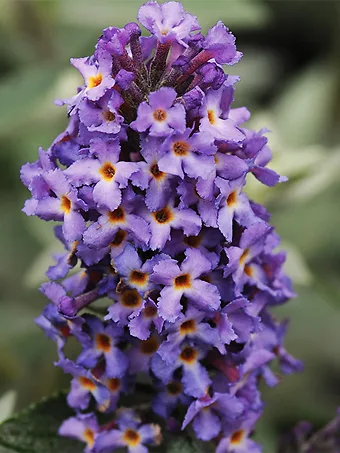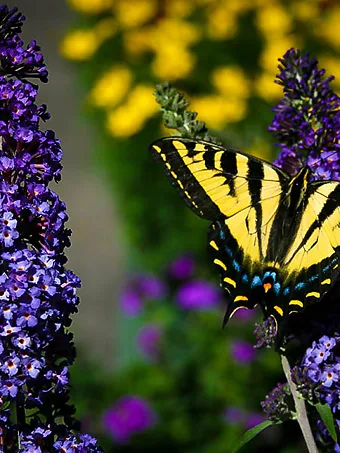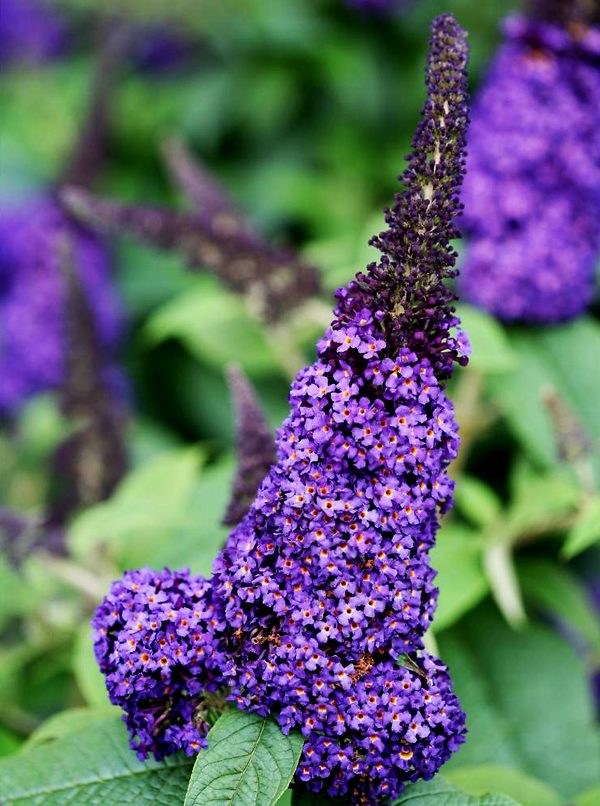
Pugster® Blue Butterfly Bush
Buddleja 'SMNBDBT' (PP# 28,794)View more from Butterfly Bush
Pugster® Blue Butterfly Bush
Buddleja 'SMNBDBT' (PP# 28,794)
30 day - ARRIVE AND THRIVE™ guaranteeLearn more


Special Features

Botanical Name
Buddleja 'SMNBDBT' (PP# 28,794)
Outdoor Growing zone
5-9
Mature Height
2
Mature Width
2-3
Sun needs
Full Sun
The Pugster® Blue Butterfly Bush is a breakthrough plant featuring full-sized, classic flower spikes that are sweetly scented and a deep, rich blue, on a compact bush that is only 2 feet tall and wide. It blooms from mid-summer right until the first hard frost, with a continuous succession of flower spikes on every stem. The gray-green foliage makes the perfect backdrop to the rich blooms, and this compact plant fits into any garden space, and it can even be grown in pots.
- Big, fat flower spikes of deep blue
- Sturdy compact bush just 2 feet tall and wide
- Blooms continuously from mid-summer to late fall
- A magnet for butterflies and hummingbirds
- Easily grown in sun and well-drained soil
Plant the Pugster® Blue Butterfly Bush in full sun, in any well-drained soil, including dry and poor soils. Avoid damp soil and shady places and protect plants from cold in zone 5. Pests and diseases are normally never problems, and a simple spring pruning is all it takes to keep your plant vigorous and blooming profusely. We recommend removing the flower spikes as they go over, for appearance and to prevent seed production.
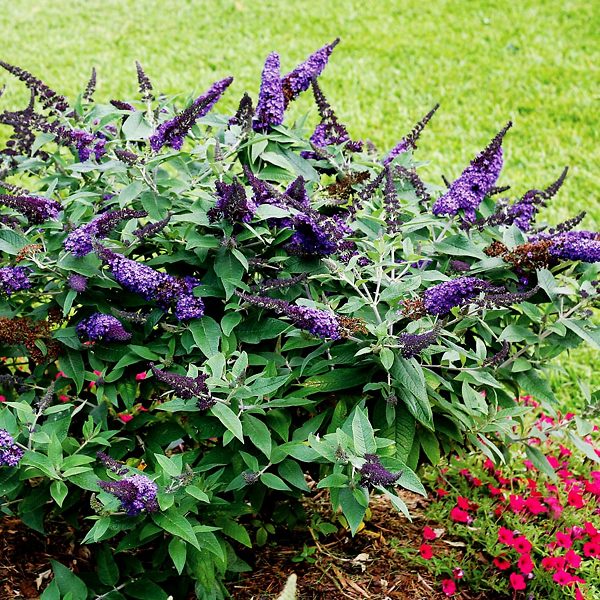
Butterfly bushes are adored by gardeners, children, butterflies, and hummingbirds too. A plant in your garden is a magnet for all these creatures, but old varieties grow so large. They are big, awkward plants that need lots of room and lots of attention – or at least that is how it used to be. Most of the newer varieties around are attractive, but they have relatively small flowers, and if you love those old-fashioned, sweetly-scented big spikes of blooms, you could be disappointed. At least, that’s how it used to be. Today we have the Pugster® range, with those traditional big flower spikes, but on a compact plant that is as cute as the pug dogs whose name they take. Blue is the classic butterfly bush color, and precious for its relative rarity, but with the Pugster® Blue Butterfly Bush you can now enjoy rich, dark-blue blooms on huge flower spikes, on a small bush that fits into any garden, and that can even be grown in planters and pots on a balcony.
The Pugster Blue Butterfly Bush is a multi-stem bush growing about 2 feet tall and spreading 2 to 3 feet wide. In warmer zones, it may grow a little larger, but some simple spring pruning will allow you to control the size for your needs. The leaves are long and slender, in pairs along the stems, which have flaking gray-brown bark. Leaves are 4½ inches long, and 1½ inches wide, tapering to a long point, and they are close together on the stems, giving you an attractive, bushy plant. The leaves have a soft, fuzzy texture, with pronounced veins, and they are a muted green, with a more gray-green tone to the undersides. The branches on this vigorous bush thrust out at about 45o, making for an upright plant that doesn’t flop or sprawl.
By mid-summer your bush will be blooming, and it continues to bloom right through the hottest months, and into fall until the first hard frost. Every branch ends in a large flower spike, held upright so you can really appreciate it. The fat spikes are over 6 inches tall, and packed with literally thousands of tiny flowers, which open in succession from the bottom to the top of the spike. Each flower is sweetly scented, and vibrantly colored like a tiny jewel, in a deep, rich blue -purple color, and it takes about 3 weeks from the first signs of a bloom to the upper flowers fading. We recommend you remove spent flower spikes once they become mostly brown from the dead flowers, to keep your bush colorful and fresh. It only takes a few moments to snip them off, just above the first pair of leaves. New shoots, carrying more flower spikes, will sprout quickly, so blooms follow blooms in succession for months.
The Pugster Blue Butterfly Bush should be planted in full sun, in a warm location, especially in cooler zones. It is hardy from zone 5 to zone 9, and it grows best in well-drained soil. Good drainage is especially important in zones 5, for winter survival. Slopes and raised areas are best, and avoid low-lying, damp spots. All soils are fine with this vigorous plant, and once established dry periods are not only enjoyed, but they encourage more flowering. This plant thrives in sun and heat, and too much water is never good. Pests and diseases leave it alone, and this plant is normally trouble-free. Besides removing the dead flower spikes, a spring pruning is advised, for the best growth and vigor, and to maintain a compact form, especially in hot zones. Wait in spring until you see the first tiny leaves appearing, and then remove all thin or damaged branches. Shorten back the remaining sturdy stems by about one-third to one-half, depending on how much growth has over-wintered, and the size of bush you want. Cut back to just above a pair of healthy buds. In a few weeks your bush will be leafy and fresh, and soon the blooms will return. Butterfly bushes are slow to sprout in spring, so be patient and wait for the growth before pruning. Even if the stems are killed down to the ground in cold zones, new shoots will rise from the base, and flowering will be just as prolific. This plant is noted for its vigorous growth and sturdy structure.
The butterfly bush, Buddleja davidii, was brought to Europe by a missionary and naturalist called Pere Armand David, in 1869. It grows in China and Tibet, among rocks and on rough ground. Many colors were developed from it, and the butterfly bush became a very popular garden plant. Recently it has seen some negative publicity because in some areas – chiefly the north-west and some parts of the south – it has escaped into wild areas, competing with native plants. In all the cooler parts of the country this doesn’t happen, and if you dead-head regularly your plant won’t make seed anyway, so it can’t spread. Some years ago, Timothy Wood, of Spring Meadow Nursery, Inc, in Spring Lake, Michigan, decided to develop some new, compact varieties, and he created the trademarked Pugster® series. For the plant called Pugster® Blue he began with a hardy English variety growing to about 6 feet called Adokeep’ (sold as Adonis Blue). He used pollen from it to make seeds on a dwarf form of his own breeding, called `UC 596`. The seeds were created in 2012, and the following year he selected a promising plant with deep blue flowers and a compact form. After successful trials he named it ‘SMNBDBT’ and patented it in 2016. These new, compact butterfly bushes are hugely popular, and our supply of plants will soon be gone. Order now and enjoy classic Buddleja blooms on a compact plant that fits into any garden.
